Ahmed Raza Khan Barelvi
| Ahmed Raza Khan احمد رضا خان | |
|---|---|
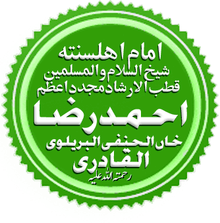 | |
| Title |
|
| Born |
14 June 1856[1] Bareilly, North-Western Provinces, British Indian Empire |
| Died |
28 October 1921 (aged 65) Muhallah Sodagraan, Bareilly, UP, British Indian Empire |
| Nationality | India |
| Era | Modern era |
| Region | South Asia |
| Religion | Islam |
| Jurisprudence | Hanafi[2] |
| Creed | Sunni[2] |
| Main interest(s) | Aqeedah, Fiqh, Tasawwuf |
| Website | www.alahazrat.net |
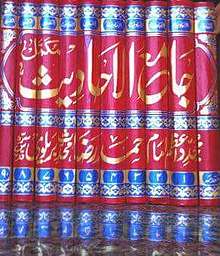
Ahmed Raza Khan (Arabic: أحمد رضا خان, Persian: احمد رضا خان, Urdu: احمد رضا خان , Hindi: अहमद रज़ा खान), commonly known as Ahmed Raza Khan Barelwi, Ahmed Rida Khan in Arabic, or simply as "Ala-Hazrat" (14 June 1856 CE or 10 Shawwal 1272 AH – 28 October 1921 CE or 25 Safar 1340 AH), was an Islamic scholar, jurist, theologian, ascetic, Sufi, and reformer in British India,[3] and the founder of the Barelvi movement.[4][5][6] Raza Khan wrote on numerous topics, including law, religion, philosophy and the sciences.
Life
Early life and family
Ahmed Raza Khan Barelvi's father, Naqi Ali Khan, was the son of Raza Ali Khan.[7][8][9][9] Ahmed Raza Khan Barelvi belonged to the Barech tribe of Pushtuns.[7] The Barech formed a tribal grouping among the Rohilla Pushtuns of North India who founded the state of Rohilkhand. Khan's ancestors migrated from Qandahar during the Mughal rule and settled in Lahore.[7][8]
Khan was born on 14 June 1856 in Mohallah Jasoli, Bareilly Sharif, the North-Western Provinces. His birth name was Muhammad.[10] Khan used the appellation "Abdul Mustafa" ("servant of the chosen one") prior to signing his name in correspondence.[11]
Khan saw an intellectual and moral decline of Muslims in British India.[12] His movement was a mass movement, defending popular Sufism, which grew in response to the influence of the Deobandi movement in South Asia and the Wahhabi movement elsewhere.[13]
Today the movement is spread across the globe with followers in Pakistan, India, Bangladesh, Turkey, Afghanistan, Iraq, Sri Lanka, South Africa, United States, and UK among other countries. The movement now has over 200 million followers.[14] The movement was largely a rural phenomenon when begun, but is currently popular among urban, educated Pakistanis and Indians as well as South Asian diaspora throughout the world.[15]
Many religious schools, organizations and research institutions teach Khan's ideas,[16] which emphasize the primacy of Islamic law over adherence to Sufi practices and personal devotion to the prophet Muhammad.
Death
Khan died on Friday 28 October 1921 CE (25th Safar 1340h) at the age of 65, in his home at Bareilly.[17] He was buried in the Dargah AlaHazrat which marks the site for the annual Urs-e-Razavi.
Works
Khan wrote books in Arabic, Persian and Urdu, including the thirty-volume fatwa compilation Fatawa Razaviyya, and Kanzul Iman (Translation & Explanation of the Holy Qur'an). Several of his books have been translated into European and South Asian languages.[18][19]
Kanzul Iman (translation of the Qur'an)
Kanzul Iman (Urdu and Arabic: کنزالایمان) is a 1910 Urdu paraphrase translation of the Qur'an by Khan. It is associated with the Hanafi jurisprudence within Sunni Islam,[20] and is a widely read version of translation in the Indian Subcontinent. It has been subsequently translated into English, Hindi, Bengali, Dutch, Turkish, Sindhi, Gujarati and Pashto.[19]
Husamul Haramain
Husamul Haramain or Husam al Harmain Ala Munhir kufr wal myvan (The Sword of the Haramayn at the throat of unbelief and falsehood) 1906, is a treatise which declared infidels the founders of the Deobandi, Ahle Hadith and Ahmadiyya movements on the basis that they did not have the proper veneration of the Prophet Muhammad and finality of Prophethood in their writings.[21][22][23][24] In defense of his verdict he obtained confirmatory signatures from 268 traditional Sunni scholars in South Asia,[25] and some from scholars in Mecca and Medina. The treatise is published in Arabic, Urdu, English, Turkish and Hindi.[26]
Fatawa Razawiyyah
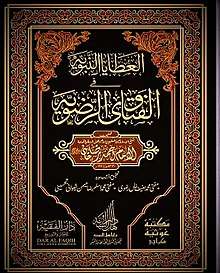
Fatawa-e-Razvia or Fatawa-e-Radaviyyah is the main fatwa (Islamic verdicts on various issues) book of his movement.[27][28] It has been published in 30 volumes and in approx. 22,000 pages. It contains solution to daily problems from religion to business and from war to marriage.[29][30]
Hadayake Bakhshish
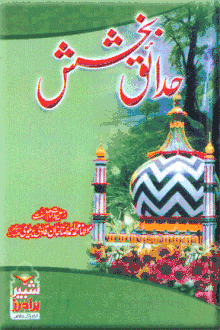
He wrote devotional poetry in praise of the Prophet Muhammad and always discussed him in the present tense.[31] His main book of poetry is Hidayake Bakhshish.[32] His poems, which deal for the most part with the qualities of the Prophet, often have a simplicity and directness.[33] They reportedly created a favorable climate for na'at writing.[34] His Urdu couplets, entitled Mustafa jaane rahmat pe lakhon salaam (Millions of salutations on Mustafa, the Paragon of mercy), are read in movements mosques. They contain praise of the Prophet, his physical appearance (verses 33 to 80), his life and times, praise of his family and companions, praise of the awliya and saleheen (the saints and the pious).[35][36]
Other
His other works include:[5][19]
- Ad Daulatul Makkiya Bil Madatul Ghaibiya
- Al Mu'tamadul Mustanad
- Al Amn o wa Ula
- Alkaukabatush Shahabiya
- Al Istimdaad
- Al Fuyoozul Makkiyah
- Al Meeladun Nabawiyyah
- Fauze Mubeen Dar Harkate Zameen
- Subhaanus Subooh
- Sallus Say yaaful Hindiya
- Ahkaam-e-Shariat
- Az Zubdatuz Zakkiya
- Abna ul Mustafa
- Tamheed-e-Imaan
- Angotthe Choomne ka Masla
Beliefs
Khan supported Tawassul, Mawlid, the prophet Muhammad's awareness of all things unseen, and other Sufi practices which were opposed by Wahhabis and Deobandis.[31][37][38]
In this context he supported the following beliefs:
- Muhammad, although is insan-e-kamil (the perfect human), possessed a nūr (light) that predates creation. This contrasts with the Deobandi view that Muhammad, was only a insan-e-kamil, a respected but physically typical human just like other humans.[39][40]
- Muhammad is haazir naazir (can be see many places at the same time and reach on desired place by the power given by God, :[41]
We do not hold that anyone can equal the knowledge of Allah Most High, or possess it independently, nor do we assert that Allah's giving of knowledge to the Prophet (Allah bless him and give him peace) is anything but a part. But what a patent and tremendous difference between one part [the Prophet's] and another [anyone else's]: like the difference between the sky and the earth, or rather even greater and more immense.
— Ahmed Raza Khan, al-Dawla al-Makkiyya (c00), 291.
He reached judgements with regard to certain practices and faith in his book Fatawa-e-Razvia, including:[42][43] [17]
- Islamic Law Shari'ah is the ultimate law and following it is obligatory for all Muslims;
- To refrain from Bid'ah is essential;
- A Sufi without knowledge or a Shaykh without actions is a tool in the hands of the devil;
- It is impermissible to imitate the Kuffar, to mingle with the misguided [and heretics] and to participate in their festivals.
Permissibility of currency notes
In 1905, Khan, on the request of contemporaries from Hijaz, wrote a verdict on the permissibility of using paper as form of currency, entitled Kifl-ul-Faqeehil fehim Fe Ahkam-e-Kirtas Drahim.[44]
Ahmadiyyah
Mirza Ghulam Ahmad of Qadian claimed to be the Promised Messiah and Mahdi awaited by some Muslims as well as a Ummati Nabi, a subordinate prophet to Muhammad who came to restore Islam to the Pristine form as practiced by Muhammad and early Sahaba.[45][46] Khan declared Mirza Ghulam Ahmad a heretic and apostate and called him and his followers as disbelievers or kuffar.[47]
Deobandis
When Imam Ahmed Raza Khan visited Mecca and Medina for pilgrimage in 1905, he prepared a draft document entitled Al Motamad Al Mustanad ("The Reliable Proofs"). In this work, Ahmad Raza branded Deobandi leaders such as Ashraf Ali Thanwi, Rashid Ahmad Gangohi, and Muhammad Qasim Nanotwi and those who followed them as kuffar. Khan collected scholarly opinions in the Hejaz and compiled them in an Arabic language compendium with the title, Husam al Harmain ("The Sword of Two Sanctuaries"), a work containing 34 verdicts from 33 ulama (20 Meccan and 13 Medinese). This work initiated a reciprocal series of fatwas between Barelvis and Deobandis lasting to the present.[48]
Shia
Khan wrote various books against beliefs and faith of Shia Muslims and declared various practices of Shia as kufr.[49] Most Shiites of his day were apostates because, he believed, they repudiated necessities of religion.[50][51]
Muhammad Ibn Al-Wahhab
Khan declared Wahabis as kuffār and collected many fatwas of various scholars against the Wahabbi movement founded by Muhammad ibn Abd al-Wahhab, who was predominant in the Arabian peninsula, just as he had done with the Ahmadis and Deobandis.[52]
Political views
Unlike other Muslim leaders in the region at the time, Khan and his movement opposed the Indian independence movement due to its leadership under Mahatma Gandhi, who was not a Muslim.[53]
Khan declared that India was Dar al-Islam and that Muslims enjoyed religious freedom there. According to him, those arguing the contrary merely wanted to take advantage of the provisions allowing Muslims living under non-Muslim rule to collect interest from commercial transactions and had no desire to fight Jihad or perform Hijra.[54] Therefore, he opposed labeling British India to be Dar al-Harb ("land of war"), which meant that waging holy war against and migrating from India were inadmissible as they would cause disaster to the community. This view of Khan's was similar to other reformers Syed Ahmed Khan and Ubaidullah Ubaidi Suharwardy.[55]
The Muslim League mobilized the Muslim masses to campaign for Pakistan,[56] and many of Khan's followers played a significant and active role in the Pakistan Movement at educational and political fronts.[57] The founder of Pakistan, Mohammad Ali Jinnah, had a private meetings with many jurists, including Ahmad Raza Khan, asking for their support in the Pakistan movement. Jinnah received full support in the Pakistan movement from Khan and also given political advice. (Wrong as Ahmad raza Khan was dead in 1921 but Pakistan movement started after 1933 )
Legacy
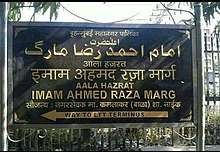
Recognition
- On 21 June 2010, Muhammad al-Yaqoubi, a cleric and Sufi from Syria, declared on Takbeer TV's programme Sunni Talk that the Mujaddid of the Indian subcontinent was Ahmed Raza Khan Barelvi, and said that a follower of Ahlus Sunnah wal Jamaah can be identified by his love of Khan, and that those outside of that those outside the Ahlus Sunnah are identified by their attacks on him.[58]
- Muhammad Iqbal (1877–1938), a poet and philosopher, said: "I have carefully studied the decrees of Imam Ahmed Raza and thereby formed this opinion; and his Fatawa bear testimony to his acumen, intellectual caliber, the quality of his creative thinking, his excellent jurisdiction and his ocean-like Islamic knowledge. Once Imam Ahmed Raza forms an opinion he stays firm on it; he expresses his opinion after a sober reflection. Therefore, the need never arises to withdraw any of his religious decrees and judgments. With all this, by nature he was hot tempered, and if this was not in the way, then Shah Ahmed Raza would have been the Imam Abu Hanifa of his age."[59] In another place he says, "Such a genius and intelligent jurist did not emerge."[60]
- ‘Ali bin Hassan Maliki, Mufti of Mecca, called Khan the encyclopaedia of all religious sciences.[17]
Societal influence
- Ala Hazrat Express is an express train belonging to Indian Railways that runs between Bareilly and Bhuj in India.[61]
- The Indian government issued a commemorative postal stamp in honour of Ahmad Raza Khan on 31 December 1995.[62][63]
Spiritual successors
He had many disciples and successors, including 30 in the Indian subcontinent and 35 elsewhere.[64]
See also
References
- ↑ Hayat-e-Aala Hadhrat, vol.1 p.1
- 1 2 Rahman, Tariq. "Munāẓarah Literature in Urdu: An Extra-Curricular Educational Input in Pakistan's Religious Education." Islamic Studies (2008): 197–220.
- ↑ "Early Life of Ala Hazrat".
- ↑ See: He denied and condemned Taziah, Qawwali, tawaf of mazar, sada except Allah, women visiting at Shrines of Sufis.
- Illustrated Dictionary of the Muslim World (2011), p. 113. Marshall Cavendish, ISBN 9780761479291
- Globalisation, Religion & Development (2011), p. 53. Farhang Morady and İsmail Şiriner (eds.). London: International Journal of Politics and Economics.
- Rowena Robinson (2005) Tremors of Violence: Muslim Survivors of Ethnic Strife in Western India, p. 191. Thousand Oaks: Sage Publications, ISBN 0761934081
- Roshen Dalal (2010) The Religions of India: A Concise Guide to Nine Major Faiths, p. 51. Revised edition. City of Westminster: Penguin Books, ISBN 9780143415176
- Barbara D. Metcalf (2009) Islam in South Asia in Practice, p. 342. Princeton: Princeton University Press.
- The Columbia World Dictionary of Islamism (2007), p. 92. Oliver Roy and Antoine Sfeir (eds.), New York: Columbia University Press.
- Gregory C. Doxlowski and Usha Sanyal (Oct–Dec 1999). "Devotional Islam and Politics in British India: Ahmad Riza Khan Barelwi and His Movement, 1870–1920". Journal of the American Oriental Society. 119 (4): 707–709. doi:10.2307/604866. JSTOR 604866.
- Elizabeth Sirriyeh (1999) Sufis and Anti-Sufis: The Defense, Rethinking and Rejection of Sufism in the Modern World, p. 49. London: Routledge, ISBN 0-7007-1058-2.
- 1 2 Usha Sanyal (1998). "Generational Changes in the Leadership of the Ahl-e Sunnat Movement in North India during the Twentieth Century". Modern Asian Studies. 32 (3): 635. doi:10.1017/S0026749X98003059.
- ↑ Riaz, Ali (2008). Faithful Education: Madrassahs in South Asia. New Brunswick, NJ: Rutgers University Press. p. 75. ISBN 978-0-8135-4345-1.
The emergence of Ahl-e-Sunnat wa Jama'at ... commonly referred to as Barelvis, under the leadership of Maulana Ahmed Riza Khan (1855–1921) ... The defining characteristic ... is the claim that it alone truly represents the sunnah (the Prophetic tradition and conduct), and thereby the true Sunni Muslim tradition.
- 1 2 3 "The blessed Genealogy of Sayyiduna AlaHadrat Imam Ahmad Rida Khan al-Baraylawi Alaihir raHmah | Alahzrat's Ancestral Tree". alahazrat.net. Archived from the original on 13 July 2015. Retrieved 28 July 2015.
- 1 2 "New Page 2". taajushshariah.com. Retrieved 28 July 2015.
- 1 2 "Alahazrat Childhood". alahazrat.net. Archived from the original on 29 July 2015. Retrieved 28 July 2015.
- ↑ Ala Hadhrat by Bastawi, p. 25
- ↑ Man huwa Ahmed Rida by Shaja'at Ali al-Qadri, p.15
- ↑ Marshall Cavendish Reference (2011). Illustrated Dictionary of the Muslim World. Marshall Cavendish. pp. 113–. ISBN 978-0-7614-7929-1.
- ↑ Robert L. Canfield (30 April 2002). Turko-Persia in Historical Perspective. Cambridge University Press. pp. 131–. ISBN 978-0-521-52291-5.
- ↑ "Search Results". oxfordreference.com.
- ↑ "Ahl al-Sunnah wa'l-Jamaah". oxfordreference.com.
- ↑ Usha Sanyal. Generational Changes in the Leadership of the Ahl-e Sunnat Movement in North India during the Twentieth Century. Modern Asian Studies (1998), Cambridge University Press
- 1 2 3 Usha Sanyal (1996). Devotional Islam and Politics in British India: Ahmad Riza Khan Barelwi and His Movement, 1870–1920. Oxford University Press. ISBN 978-0-19-564862-1.
- ↑ Skreslet, Paula Youngman, and Rebecca Skreslet. (2006). The Literature of Islam: A Guide to the Primary Sources in English Translation. Rowman & Littlefield. ISBN 978-0-8108-5408-6
- 1 2 3 Maarif Raza, Karachi, Pakistan. Vol.29, Issue 1–3, 2009, pages 108–09
- ↑ Paula Youngman Skreslet; Rebecca Skreslet (2006). The Literature of Islam: A Guide to the Primary Sources in English Translation. Rowman & Littlefield. pp. 232–. ISBN 978-0-8108-5408-6.
- ↑ "Trysts with Democracy". google.co.in.
- ↑ "Muslimischer Nationalismus, Fundamentalismus und Widerstand in Pakistan". google.co.in.
- ↑ Usha Sanyal Devotional Islam and Politics in British India: Ahmad Raza Khan Barelwi and His Movement, 1870–1920
- ↑ Ismail Khan (19 October 2011). "The Assertion of Barelvi Extremism". Hudson Institute. Retrieved 28 July 2015.
- ↑ "Holy Quran's Judgement ? Part 2". google.co.in.
- ↑ "Islamic Reform in South Asia". google.co.in.
- ↑ "Jamia Rizvia of Bareilly to be upgraded to a university". milligazette.com.
- ↑ Maulana Shakir Noorie (10 October 2008). What is Sacrifice?: Qurbani kya hai?. Sunni. pp. 12–. GGKEY:G6T13NU1Q2T.
- ↑ "Dargah Ala Hazrat: Fatva Razabia is encyclopedia of Fatvas". jagran. 18 December 2014.
- ↑ David Emmanuel Singh (2012). Islamization in Modern South Asia: Deobandi Reform and the Gujjar Response. Walter de Gruyter. pp. 32–. ISBN 978-1-61451-246-2.
- 1 2 Ian Richard Netton (19 December 2013). Encyclopaedia of Islam. Routledge. pp. 88–. ISBN 978-1-135-17960-1.
- ↑ Raza, Muhammad Shahrukh. "sharah hadaiq e bakhshish - Books Library - Online School - Read - Download - eBooks - Free - Learning - Education - School - College - University - Guide - Text Books - Studies". Retrieved 24 November 2016.
- ↑ Contributions to Indian Sociology. Mouton. 1993.
- ↑ Muhammad Yusuf Abbasi (1992). Pakistani culture: a profile. National Institute of Historical and Cultural Research. ISBN 978-969-415-023-9.
- ↑ "Salaam by Imam Ahmed Raza Khan". 19 December 2007. Retrieved 24 November 2016.
- ↑ Noormuhammad, Siddiq Osman. "Salaam by Imam Ahmed Raza Khan". Retrieved 24 November 2016.
- ↑ Abdulkader Tayob; Inga Niehaus; Wolfram Weisse. Muslim Schools and Education in Europe and South Africa. Waxmann Verlag. pp. 64–. ISBN 978-3-8309-7554-0.
- ↑ Abdulkader Tayob; Inga Niehaus; Wolfram Weisse. Muslim Schools and Education in Europe and South Africa. Waxmann Verlag. pp. 76–. ISBN 978-3-8309-7554-0.
- ↑ Pakistan perspectives, Volume 7. Pakistan Study Centre, University of Karachi, 2002
- ↑ Akbar S. Ahmed (1999) Islam today: a short introduction to the Muslim world. I.B. Tauris Publishers, ISBN 978-1-86064-257-9
- ↑ N. C. Asthana & A.Nirmal (2009) Urban Terrorism : Myths And Realities. Publisher Pointer Publishers, ISBN 978-81-7132-598-6, p. 67
- ↑ Yoginder Sikand (24 August 2005). Bastions of The Believers: Madrasas and Islamic Education in India. Penguin Books Limited. pp. 73–. ISBN 978-93-5214-106-7.
- ↑ Sita Ram Sharma (1998). Politics and government of communalism. APH Publishing Corporation. ISBN 978-81-7024-933-7.
- ↑ "Phamphlet on Currency". www.dawateislami.net. Archived from the original on 2016-04-04.
- ↑ "My Claim to Promised Messiahship - The Review of Religions". reviewofreligions.org. Retrieved 28 July 2015.
- ↑ Ahmad, Hazrat Mirza Ghulam (28 March 2018). "Elucidation of Objectives: English Translation of Taudih-e-Maram : a Treatise". Islam International. Retrieved 28 March 2018 – via Google Books.
- ↑ Aziz, Zahid. (2008). A survey of the Lahore Ahmadiyya movement: history, beliefs, aims and work. Ahmadiyya Anjuman Ishaat Islam (AAIIL), UK. p. 43, ISBN 978-1-906109-03-5.
- ↑
- ↑ Sampark: Journal of Global Understanding. Sampark Literary Services. 2004.
- ↑ Fatawa-e-Razavia, Fatwa on Sunni marriage with shia, Book of Marriage; vol.11/pg345, Lahore edition
- ↑ http://www.islamic.pwp.blueyonder.co.uk/Fiqh/Sunni%20marriage%20with%20Shia.htm%5Bpermanent+dead+link%5D
- ↑ "Kafirs". Archived from the original on 12 June 2002. Retrieved 28 July 2015.
- ↑ R. Upadhyay, Barelvis and Deobandhis: "Birds of the Same Feather". Eurasia Review, courtesy of the South Asia Analysis Group. 28 January 2011.
- ↑ Ayesha Jalal (30 June 2009). Partisans of Allah: Jihad in South Asia. Harvard University Press. pp. 146–. ISBN 978-0-674-03907-0.
- ↑ M. Naeem Qureshi (1999). Pan-Islam in British Indian Politics: A Study of the Khilafat Movement, 1918–1924. BRILL. pp. 179–. ISBN 90-04-11371-1.
- ↑ Ingvar Svanberg; David Westerlund (6 December 2012). Islam Outside the Arab World. Routledge. pp. 220–. ISBN 978-1-136-11322-2.
- ↑ Imam, Muhammad Hassan. (2005). The Role of the Khulafa-e-Imam Ahmed Raza Khan in the Archived 29 June 2015 at the Wayback Machine. Pakistan Movement 1920–1947. Diss. Karachi: University of Karachi.
- ↑ "Shaykh Yaqoubi Advocates Imam Ahmed Raza as a Mujaddid from Indian Subcontinent !!!!". Sunni Talk. Takbeer TV. 21 June 2010. Retrieved 19 August 2011.
- ↑ Arafat, 1970, Lahore.
- ↑ Weekly Uffaq, Karachi. 22–28 January 1979.
- ↑ http://runningstatus.in/. "Ala Hazrat Express/14312 Live Running Train Status". runningstatus.in. Retrieved 28 July 2015.
- ↑ "Ala Hazrat Barelvi Commemorative Stamp". stampsathi.in. Retrieved 28 July 2015.
- ↑ Commemorative Stamps, India.
- ↑ Shah Ahmed Rida Khan – The "Neglected Genius of the East" by Professor Muhammad Ma'sud Ahmad M.A. P.H.D. – Courtesy of "The Muslim Digest", May/June, 1985, pp. 223–230
Further reading
- Baraka, A. (2003). A Saviour in a Dark World (Article). The Islamic Times, March 2003. Stockport, UK: Raza Academy.
- Haroon, Muhammad. (1994). The World Importance of Imam Ahmed Raza Khan Barelvi. Stockport, UK: Raza Academy. ISBN 9781873204122
- Imam, Muhammad Hassan. (2005). The Role of the Khulafa-e-Imam Ahmed Raza Khan in Pakistan Movement 1920–1947. Diss. Karachi: University of Karachi.
- Azimbadi, Badr. (2005).Great Personalities in Islam. Adam Publishers.
External links
| Wikibooks has a book on the topic of: Husam ul Harmain |
